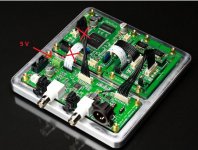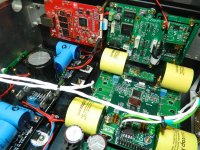Thanks a lot wktk! You've nailed it with this one!
The 1.2V Trident just goes on it's knees on everything over 192khz, it goes down to 0,86V. Had to raise the voltage on Placid all the way to 6V to get around 1V out of Trident - just to confirm it playing.
WhiteBull:
Glad you address the problem, congratulations!
wktk_smile :
I didn't realize the problem was caused by the 1.2V power supply. Thanks wktk_smile for your experience.
Ian
umm, where is the source coming from? you have disconnected both the inputs for audio, or you will use i2s input from USB or something?
It's Ian's picture, but yes i2s input from usb (waveio)
I know its Ians picture, but you made no comment, nor indication of where the signal might come from in your notes. so yes if you power the board separately, you can use it like that.
Cool, thanks qusp
Hi Ian,
I'd like to try the isolator board BUT I need spdif out, also using the si570, like its sound. Can I remove the ribbon cable (dont use the fifo input) and power the board seperately like in the attached pic? Thanks!
Hi edbk,
If you don't need input I2S from spdif board, yes, you don't need the black I2S input cable.
However you have to use the white FFC/FPC cable for running the spdif board.
You don't need the 5V DC input on the spdif board if it works with FIFO.
Ian
Hi edbk,
If you don't need input I2S from spdif board, yes, you don't need the black I2S input cable.
However you have to use the white FFC/FPC cable for running the spdif board.
You don't need the 5V DC input on the spdif board if it works with FIFO.
Ian
ah whoops, I knew there was something eating at me, so you still need the J7 FPC for spdif output only? what for? control signals and output selection or something? its not mentioned in the datasheet other than being for future revisions and I also guessed the spdif input selection/control was sent over it. or is i2s sent over it for output too?
see Ians post, not mine :redface: J7, it has hidden functionCool, thanks qusp
You don't need the 5V DC input on the spdif board if it works with FIFO.
Ian
the reason he asked about that, is because he wants to use the isolator on the fifo (between the fifo and clock boards I guess), which would be circumvented if using the MCLK and i2s connected to the spdif output board from the clock board.
the reason he asked about that, is because he wants to use the isolator on the fifo (between the fifo and clock boards I guess), which would be circumvented if using the MCLK and i2s connected to the spdif output board from the clock board.
Yes exactly, I dont quite get why the ribbon cable is needed then? The spdif board cant be used standalone to convert i2s to spdif?
ah whoops, I knew there was something eating at me, so you still need the J7 FPC for spdif output only? what for? control signals and output selection or something? its not mentioned in the datasheet other than being for future revisions and I also guessed the spdif input selection/control was sent over it. or is i2s sent over it for output too?
DIX9211 doesn't has hardware mode, so I have to run it from SPI
If really need isolating the spdif board, I suggest isolateing the SPI bus from the FFC/FPC cable. I can post signal details.
Regards,
Ian
For some time we worked on Edel Renderer - Ian's FIFO - Buffalo DAC - DNT1 I / V.
Now everything works perfectly and I am very pleased with the sound.
My taste ... sounds better without insulator between FIFO and XO.
Both modules are powered from PSU Salas.
In a few days i receive from Germany A123.
Please tell me , how can I separate power XO with A123?
Now XO is powered by FIFO by FFC Flexible Flat Cables.
If you use batteries for XO, you must remove FFC Flexible Flat Cables?
Thank you!
Excuse my English: (
Now everything works perfectly and I am very pleased with the sound.
My taste ... sounds better without insulator between FIFO and XO.
Both modules are powered from PSU Salas.
In a few days i receive from Germany A123.
Please tell me , how can I separate power XO with A123?
Now XO is powered by FIFO by FFC Flexible Flat Cables.
If you use batteries for XO, you must remove FFC Flexible Flat Cables?
Thank you!
Excuse my English: (
Attachments
For some time we worked on Edel Renderer - Ian's FIFO - Buffalo DAC - DNT1 I / V.
Now everything works perfectly and I am very pleased with the sound.
My taste ... sounds better without insulator between FIFO and XO.
Both modules are powered from PSU Salas.
In a few days i receive from Germany A123.
Please tell me , how can I separate power XO with A123?
Now XO is powered by FIFO by FFC Flexible Flat Cables.
If you use batteries for XO, you must remove FFC Flexible Flat Cables?
Thank you!
Excuse my English: (
Hi vitalica,
Your DAC looks nice. My D1 I/V is still BOM. I need to speed up to catch up with you.
If you use battery direct power the XO, you have to use the isolator board.
FIFO power the isolator from one side by a FFC cable, and XO power the isolator from the other side by other cable. Isolator will isolate the two power supply
Ian
DIX9211 doesn't has hardware mode, so I have to run it from SPI.
If really need isolating the spdif board, I suggest isolateing the SPI bus from the FFC/FPC cable. I can post signal details.
Regards,
Ian
Ok, to simplify matters, can I use a 2nd isolator board between fifo and spdif board then?
For some time we worked on Edel Renderer - Ian's FIFO - Buffalo DAC - DNT1 I / V.
Now everything works perfectly and I am very pleased with the sound.
My taste ... sounds better without insulator between FIFO and XO.
Both modules are powered from PSU Salas.
In a few days i receive from Germany A123.
Please tell me , how can I separate power XO with A123?
Now XO is powered by FIFO by FFC Flexible Flat Cables.
If you use batteries for XO, you must remove FFC Flexible Flat Cables?
Thank you!
Excuse my English: (
I was thinking about why you feel it sounds better without the isolator.
Basically the function of the isolator is to isolate the power supply and ground loop between FIFO and clock board to make a better low noise power supply working for XO.
If your XO power supply is at same noise level as the FIFO power supply, yes you are right, you may feel it sounds better if the clock board was powered from FIFO. It was because there is a CLC filter on the FIFO board. Power from FIFO board comes with lower noise after that filter.
But if you have a much better power supply for clock board, for example, a battery or ultra low noise reg, with the isolator, it will sound better for sure.
Ian
Last edited:
I was thinking about why you feel it sounds better without the isolator.
Basically the function of the isolator is to isolate the power supply and ground loop between FIFO and clock board to make a better low noise power supply working for XO.
If your XO power supply is at same noise level as the FIFO power supply, yes you are right, you may feel it sounds better if the clock board was powered from FIFO. It was because there is a CLC filter on the FIFO board. Power from FIFO board comes with lower noise after that filter.
But if you have a much better power supply for clock board, for example, a battery or ultra low noise reg, with the isolator, it will sound better for sure.
Ian
I have used so far four batteries 1,2V.
I received yesterday A123 Systems LiFePO4 cells and will make new auditions.
I'm sure it should sound better
Thanks, Ian!
Last edited:
- Home
- Source & Line
- Digital Line Level
- Asynchronous I2S FIFO project, an ultimate weapon to fight the jitter

